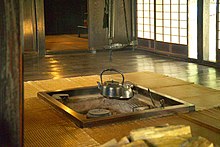Irori
Irori ( Japanese 囲 炉 裏 , also: 居 炉 裏 ) is a traditional Japanese type of stove. Irori first appeared in the Kofun period (approx. 250-538) and initially served as an additional cooking stove and for heating. The furnace type spread in the early Nara period (710 to 794). Smaller irori are used in the Japanese tea house .
For the erection of an irori a rectangular opening was cut out of the wooden floor (often the size of half a tatami ) and a lacquered wooden frame was fitted. This was filled with sand.
An irori is basically a rectangular pit with a pot hook or jizaikagi ( 自在 鉤 ). These hooks consist of a bamboo tube reaching down from the ceiling, which holds an iron wire for hanging the pot or kettle. The wire often has a handle in the shape of a fish, with which one could continuously adjust the kettle higher or lower.
